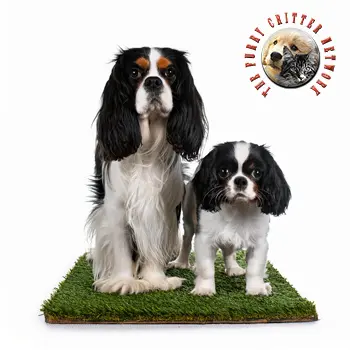Behavior
The breed is highly affectionate, playful, extremely patient and eager to please. As such, dogs of the breed are good with children and other dogs. Cavaliers are not shy about socialising with much larger dogs. They will adapt quickly to almost any environment, family, and location and suit city and country life. Their ability to bond with larger and smaller dogs makes them ideal in houses with more than one breed of dog as long as the other dog is trained. Cavaliers rank 44th in Stanley Coren's The Intelligence of Dogs, being of average intelligence in working or obedience. Cavaliers are naturally curious and playful, but also enjoy simply cuddling up on a cushion or lap, making them excellent companion or lap dogs for medical patients and the elderly.
Cavaliers are active and sporting. Cavaliers are successful in conformation shows, obedience and agility and they also make wonderful therapy dogs due to their sweet, gentle natures. The breed is adaptable in their need for exercise, happy with either sleeping on the couch or taking long walks.
The breed is well known for its loving temperament. They have an instinct to chase most things that move including vehicles on busy streets, and so most Cavaliers will never become "street-wise". As they tend to regard all strangers as friends, members of the breed will usually not make good guard dogs. Spaniels have a strong hunting instinct and may endanger birds and small animals. However, owners have reported that through training their Cavaliers they happily co-exist with a variety of small animals including hamsters and gerbils.
The Cavalier's coat requires weekly brushing, but no trimming. However, some owners prefer to trim their Cavalier's long feathers and slippers that can become very dirty when walking or playing outside.
Health
Cavaliers can notably be prone to mitral valve disease, which leads to heart failure. This appears in many Cavaliers at some point in their lives and is the most common cause of death. Some serious genetic health problems, including early-onset mitral valve disease (MVD), the potentially severely painful syringomyelia (SM), hip dysplasia, luxating patellas, and certain vision and hearing disorders are health problems for this breed. As today's Cavaliers all descend from only six dogs, any inheritable disease present in at least one of the original founding dogs can be passed on to a significant proportion of future generations. This is known as the founder effect and is the likely cause of the prevalence of MVD in the breed. Additionally, bad breeding increases the chance that a Cavalier will develop MVD, so it is important to find a responsible breeder who uses dogs with healthy hearts rather than use the first breeder you come across. The health problems shared with this breed include mitral valve disease, luxating patella, and hereditary eye issues such as cataracts and retinal dysplasia. Cavaliers are also affected by ear problems, a common health problem among spaniels of various types, and they can have such other general conditions as hip dysplasia, which are common across many types of dog breeds.






